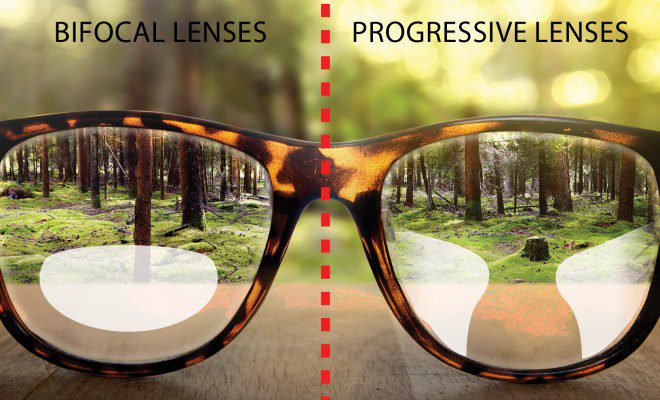
This post lists the different varieties of lenses available to customers of Debbie
Mozelle. It explains the intended wearer of each lens and informs the reader on how each lens functions.
.
Single Vision Lenses
If you are a glasses wearer who is unaware of the vast varieties of lenses offered, chances are you wear single vision lenses, lenses that have the same degree of correction all across the lens. Extremely customizable, with options for UV blocking, scratch-resistant or anti-fog coating available, these lenses correct either basic myopia (nearsightedness) or hyperopia (farsightedness). If your prescription is simply a negative or positive number, single vision lenses will be your best and least expensive option. According to Visions Canada, the average cost of a single vision lens ranges from $99-$299, depending on the brand you chose. However, suppose you have trouble seeing far away and close up or have any more complex vision issues such as astigmatism. In that case, you may want to consider purchasing one of the other varieties of lenses that includes multiple degrees of vision correction.
Bifocal lenses
When one lens has two different sections, each with a different degree of vision correction, they are referred to as bifocal lenses. The uppermost half of the frames is where you look to see far away, and the lowermost part corrects your vision of objects within 18 inches of your eyes. The majority of bifocal wearers are combating presbyopia, the loss of your eyes’ focusing capabilities. This condition is usually age-related; however,some optometrists will prescribe bifocals to young children begging to develop myopia in an attempt to reduce the severity of their nearsightedness. The need for a prescription of bifocals to children is determined on a case by case basis, so speak with an optometrist familiar with your prescription and position before making any decisions in your family.
Trifocal lenses
If you require a larger field of vision than what bifocal lenses have to offer, trifocals may be the lenses for you. As the name suggests, these lenses add a different prescription level that clarifies objects at an arm’s length, for example, computers. This “in between” perception is located at the top of your glasses frames, above the myopic and hyperopic correction measures. The closeup section of the bifocal or trifocal lenses can be shaped like a crescent, a square or a straight line, as long as it is somehow separate from the other portions of the lens.
Progressive lenses
If no distinct lines are dividing the different vision correction magnitudes, the lenses are referred to as progressives. Progressives are the latest technology that eliminates the dividing lines present in bifocals and trifocals and instead gradually increases the prescription’s strength as you look down to expand your field of vision. Progressives are generally more expensive than bifocals or trifocals, ranging in cost from $399-$1299 (Visions of Canada), and as the technology gets more readily available, the price will decrease. Something else to consider when looking at purchasing any multi-prescription glasses (bifocals, progressives of bifocals) is the training process your eyes need to go through to adjust to looking in certain places to have the ability to see certain distances. Make sure you allocate time to spend adjusting to your new lenses, as it will be disorienting for the first couple of days.
Prism lenses
The last variety of lenses this list will be looking at are prism lenses intended to correct double vision. Those with diplopia or double vision have eyes that refract light at the wrong angle, causing two of the same images to appear. The prism glasses bend the light to correct that, allowing your eyes to work together correctly to display an image. Diplopia is a rare condition, most of the time appearing as a result or symptom of another medical issue. If you suddenly begin to experience double vision that you believe may warrant these types of lenses, speak with your optometrist to determine the best path to improving your eye health.
Written by MWP Staff: Isabella Harmel
What is Vertical Heterophoria? | The Neuro Visual Center of NY
Next Post Vertical Heterophoria Exposed in ADHD
Optical Lenses: lens types, treatments & how to choose the best eyeglass lenses
https://www.webmd.com/eye-health/eyeglasses-eyes#2
What Are Single Vision Lenses and How Much Do They Cost?
https://visionsofcanada.com/products/lens-pricing-guide/#:~:text=Single%20Vi
sion%20stock%20lenses%3A,Basic%20prescription%3A%20%2499%2D%24149
Bifocals and Trifocals – A Complete Guide
https://Written by MWP Staff: Isabella Harmel
What is Vertical Heterophoria? | The Neuro Visual Center of NY
Next Post Vertical Heterophoria Exposed in ADHD
Optical Lenses: lens types, treatments & how to choose the best eyeglass lenses
https://www.webmd.com/eye-health/eyeglasses-eyes#2
What Are Single Vision Lenses and How Much Do They Cost?
https://visionsofcanada.com/products/lens-pricing-guide/#:~:text=Single%20Vi
sion%20stock%20lenses%3A,Basic%20prescription%3A%20%2499%2D%24149
Bifocals and Trifocals – A Complete Guide
https://www.webmd.com/eye-health/about-progressive-lenses#1
